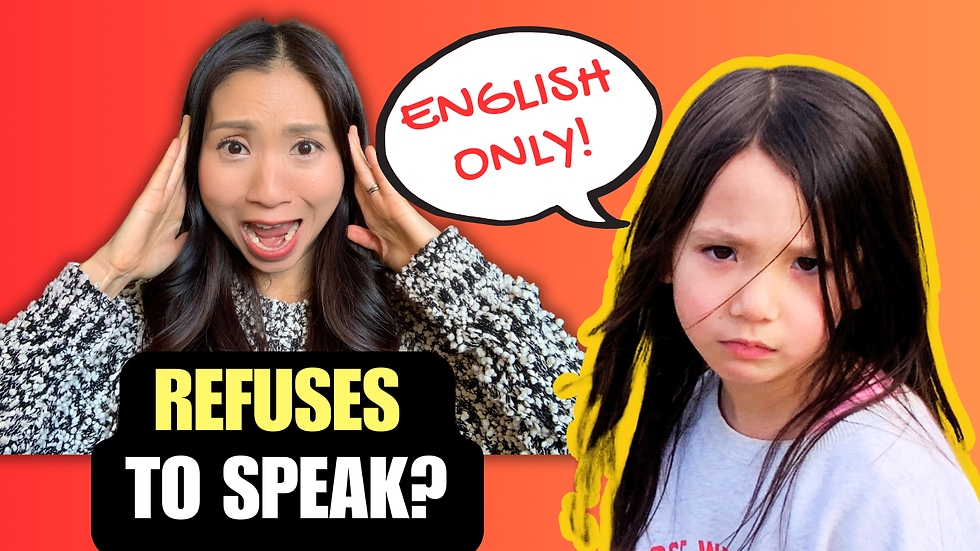Why Learning a LANGUAGE Will Give Your Child an UNFAIR ADVANTAGE – The Link Between Bilingualism and Creativity
- Ka Yee Meck
- Jul 18, 2025
- 4 min read
My daughter once called egg yolk… “egg yellow.”
We laughed.
It was adorable.

But then it hit me – this wasn’t just a cute mistranslation. She was creatively combining Chinese and English to make a joke. That’s not just language learning...
That’s creative thinking!
And in a world where AI can do almost everything, that kind of thinking might be the greatest unfair advantage of all.
The Real Edge of Language Learning
Every parent wants to give their child an edge in life – especially in a future shaped by AI.
So we enroll them in coding classes, buy them STEM kits, and maybe even language lessons.
But here’s the twist: language learning can give your child an unfair advantage – but not necessarily in the way you might think.
I’m Ka Yee, a professional translator and a mum in the UK. My husband and I have been raising our kids trilingual in Chinese, Russian, and English since 2016. People often mention better test scores or career opportunities as the perks of bilingualism. But the real benefit runs deeper: language learning fundamentally changes how kids think, especially in ways that foster creativity.
First Up: What Does “Unfair Advantage” Really Mean?

I’m borrowing this term from the book The Unfair Advantage by Ash Ali and Hasan Kubba. They argue that our hidden edges – traits, life experiences, even struggles – can shape our success.
For multilingual kids, the edge isn’t just extra vocabulary or a more impressive CV. It’s a powerful, cognitive shift. And in a world dominated by AI, this shift is priceless because it unlocks one crucial "X Factor":
Creativity.
Creativity: The Last Human Edge
AI can write essays, translate text, code, and even create music or images. As a translator, I see this firsthand. Many talented colleagues are leaving the profession due to rapid automation. But there’s one thing AI still struggles with: true creativity.
Creativity isn’t just about art. It’s about solving problems, connecting ideas, and seeing things from different perspectives.
Steve Jobs said it best: “Creativity is just connecting things.”

Furthermore, the World Economic Forum ranks creativity among the top skills for the future, right alongside critical thinking and emotional intelligence.
The Link Between Language and Creativity
How does language learning play into this?
Research shows a strong connection.
Because they scored higher in:
Cognitive Inhibition: Bilinguals constantly suppress one language while using another, honing their focus.
Cognitive Flexibility: Switching languages means switching grammar and frameworks, enhancing mental agility.
These traits create the perfect environment for creative thought.

What About Kids?
Similar findings hold true for children:
Though not every study shows a consistent edge in divergent thinking, bilingual kids consistently score higher in executive function – focus, self-control, and flexible thinking – which are foundational to creativity.
Real-Life Examples from Our Family
So what does this look like day-to-day for us as a trilingual family? In this section, I'd like to share some real-life examples from our daily life that might shed some light on the link between multilingualism and creativity.
1. Russian Fruit Save
During a board game, my kids were stuck naming fruits. At the last second, they shouted obscure fruit names — in Russian! That moment of reaching beyond English for a solution was a perfect example of divergent thinking.
2. Egg Yellow, Sky Duck, and Sky Cow
My daughter once called egg yolk “egg yellow,” a literal translation from Chinese. Another time, my son described a swan as a “sky duck” (a confusion with the Chinese “sky goose”). We now joke about “sky cows” (a Chinese term for a type of beetle), and even make up our own "sky"-series animal names! These moments show metalinguistic awareness and creative humour.
Humour researchers like John Morreall and Robert Provine say humour stems from incongruity – seeing mismatches between expectation and reality. When kids mix languages, translate literally, or create metaphors, they’re recognising perspectives and manipulating meaning. That’s creativity.
3. "Gege Boom Ya!" – Language mixing
When my daughter was 18 months old, she once said “Gege boom ya!” – a mix of Mandarin (“gege” = older brother), English (“boom” = bump), and Russian (“ya” = I). She was expressing that her brother had bumped into her. This kind of code-mixing isn’t confusion – it’s creativity and flexible problem-solving.
Why This Matters
So when I say language learning gives your child an unfair advantage, I mean:
They’ll adapt faster
Solve problems differently
See the world through multiple lenses
They’ll build not just what they know, but how they think.
And in today’s fast-changing world, that’s everything.
And the good news is that you don’t have to raise trilingual kids to enhance your child's creativity through languages.
Just introducing a second language can spark these benefits!
So if you want to future-proof your child, start with language. It might just unlock their most important superpower.
If you enjoyed this video/ blog post, check out my previous blog post where I explore the secrets of the bilingual brain!




Comments